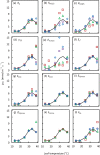Temperature response of bundle-sheath conductance in maize leaves
- PMID: 26969744
- PMCID: PMC4861018
- DOI: 10.1093/jxb/erw104
Temperature response of bundle-sheath conductance in maize leaves
Abstract
A small bundle-sheath conductance (g bs) is essential for the C4 CO2-concentrating mechanism to suppress photorespiration effectively. To predict the productivity of C4 crops accurately under global warming, it is necessary to examine whether and how g bs responds to temperature. We investigated the temperature response of g bs in maize by fitting a C4 photosynthesis model to combined gas exchange and chlorophyll fluorescence measurements of irradiance and CO2 response curves at 21% and 2% O2 within the range of 13.5-39 °C. The analysis was based on reported kinetic constants of C4 Rubisco and phosphoenolpyruvate carboxylase and temperature responses of C3 mesophyll conductance (g m). The estimates of g bs varied greatly with leaf temperature. The temperature response of g bs was well described by the peaked Arrhenius equation, with the optimum temperature being ~34 °C. The assumed temperature responses of g m had only a slight impact on the temperature response of g bs In contrast, using extreme values of some enzyme kinetic constants changed the shape of the response, from the peaked optimum response to the non-peaked Arrhenius pattern. Further studies are needed to confirm such an Arrhenius response pattern from independent measurement techniques and to assess whether it is common across C4 species.
Keywords: Diffusive resistance; Zea mays.; maximum PEPc activity; maximum Rubisco activity; modelling; warming effect.
© The Author 2016. Published by Oxford University Press on behalf of the Society for Experimental Biology.
Figures









Similar articles
-
Using a biochemical C4 photosynthesis model and combined gas exchange and chlorophyll fluorescence measurements to estimate bundle-sheath conductance of maize leaves differing in age and nitrogen content.Plant Cell Environ. 2011 Dec;34(12):2183-99. doi: 10.1111/j.1365-3040.2011.02414.x. Epub 2011 Sep 16. Plant Cell Environ. 2011. PMID: 21883288
-
Bundle-sheath leakiness in C4 photosynthesis: a careful balancing act between CO2 concentration and assimilation.J Exp Bot. 2014 Jul;65(13):3443-57. doi: 10.1093/jxb/eru157. Epub 2014 Apr 22. J Exp Bot. 2014. PMID: 24755278 Review.
-
Bundle sheath diffusive resistance to CO(2) and effectiveness of C(4) photosynthesis and refixation of photorespired CO(2) in a C(4) cycle mutant and wild-type Amaranthus edulis.Plant Physiol. 2002 Oct;130(2):964-76. doi: 10.1104/pp.008201. Plant Physiol. 2002. PMID: 12376660 Free PMC article.
-
A two-dimensional microscale model of gas exchange during photosynthesis in maize (Zea mays L.) leaves.Plant Sci. 2016 May;246:37-51. doi: 10.1016/j.plantsci.2016.02.003. Epub 2016 Feb 6. Plant Sci. 2016. PMID: 26993234
-
Deriving C4 photosynthetic parameters from combined gas exchange and chlorophyll fluorescence using an Excel tool: theory and practice.Plant Cell Environ. 2016 Jun;39(6):1164-79. doi: 10.1111/pce.12626. Epub 2016 Feb 10. Plant Cell Environ. 2016. PMID: 26286697 Review.
Cited by
-
Warming and elevated CO2 alter the transcriptomic response of maize (Zea mays L.) at the silking stage.Sci Rep. 2019 Nov 29;9(1):17948. doi: 10.1038/s41598-019-54325-5. Sci Rep. 2019. PMID: 31784668 Free PMC article.
-
The response of mesophyll conductance to short-term variation in CO2 in the C4 plants Setaria viridis and Zea mays.J Exp Bot. 2018 Feb 23;69(5):1159-1170. doi: 10.1093/jxb/erx464. J Exp Bot. 2018. PMID: 29474683 Free PMC article.
-
Influence of light and nitrogen on the photosynthetic efficiency in the C4 plant Miscanthus × giganteus.Photosynth Res. 2017 Jan;131(1):1-13. doi: 10.1007/s11120-016-0281-7. Epub 2016 Aug 16. Photosynth Res. 2017. PMID: 27531584
-
No need to switch the modified Arrhenius function back to the old form.New Phytol. 2021 Sep;231(6):2113-2116. doi: 10.1111/nph.17341. Epub 2021 Apr 4. New Phytol. 2021. PMID: 33813738 Free PMC article. No abstract available.
-
Diffusion of CO2 across the Mesophyll-Bundle Sheath Cell Interface in a C4 Plant with Genetically Reduced PEP Carboxylase Activity.Plant Physiol. 2018 Sep;178(1):72-81. doi: 10.1104/pp.18.00618. Epub 2018 Jul 17. Plant Physiol. 2018. PMID: 30018172 Free PMC article.
References
-
- Badger MR, Collatz GJ. 1977. Studies on the kinetic mechanism of ribulose-1,5-biophosphate carboxylase and oxygenase reactions, with particular reference to the effect of temperature on kinetic parameters. Carnegie Instute of Washington Yearbook 76, 355–361.
-
- Badger MR, Price GD. 1994. The role of carbonic anhydrase in photosynthesis. Annual Review of Plant Physiology and Plant Molecular Biology 45, 369–392.
-
- Barbour MM, Evans JR, Simonin KA, von Caemmerer S. 2016. Online CO2 and H2O oxygen isotope fractionation allows estimation of mesophyll conductance in C4 plants, and reveals that mesophyll conductance decreases as leaves age in both C4 and C3 plants. New Phytologist (in press). - PubMed
-
- Bellasio C, Griffiths H. 2013. Acclimation to low light by C4 maize: implications for bundle sheath leakiness. Plant, Cell and Environment 37, 1046–1058. - PubMed
Publication types
MeSH terms
Substances
LinkOut - more resources
Full Text Sources
Other Literature Sources
Miscellaneous

